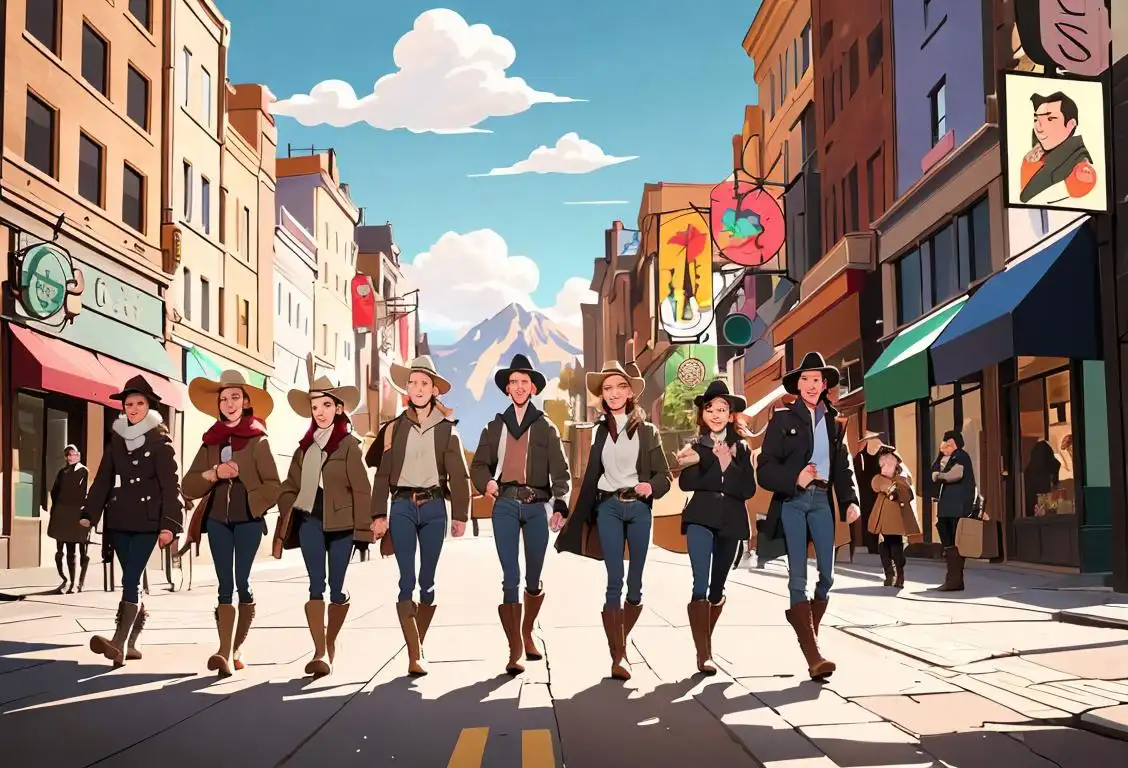National Boots Day

Ever wondered why your calendar was uncharacteristically excited about the 13th of April? It’s because we, along with possibly dozens of folks across the globe, celebrate National Boots Day! A day where inherently stylish and practical footwear takes center stage, National Boots Day has been strutting on our timelines since 2015.
When is Boots Day?
It's national boots day on the 13th April.
A Stomp Through History
While the history of boots struts its way back to ancient times (Cavemen? This fashion statement's been around since then), National Boots Day, however, seems to be a more recent phenomenon. According to our data, it appears the first digital murmur of this celebration echoed across the world wide web on April 13, 2015. Fire up your social media time-machine and you'll see folks pulling their favorite boots out of the closet, offering them a moment (or a post) in the sun.
Why April 13th?
We'll be frank here: We’re still digging into the archives of the internet to determine why this national holiday stepped forward on April 13. Maybe it's because April brings spring showers that demand galoshes and wellies. Or perhaps, it's just the day when someone looked down at their shoes and thought, ‘Hey, you deserve your own day!’
Bootiful Celebrations
The manner in which National Boots Day is observed online is as varied as a shoe shop’s offerings. Some folks pose for the ‘gram, showcasing their well-worn cowboy boots, while others offer a humble homage to their trusty hiking boots. Then there are those go-getters who spur on the community by organizing boot-wearing marches to show off their footwear's flair and endurance. Regardless of the activities, the underpinning of the day is about celebrating the versatility, comfort, and sheer style boots bring into our lives.
History behind the term 'Boots'
1200
First Recorded Use
The term 'boots' is derived from the Old French word 'botes,' which was used to describe a specific type of footwear. The first recorded use of the term can be traced back to the year 1200.
1200s
Early Roots
The term 'boots' traces its origins back to the 1200s, when it first appeared in the English language. Derived from the Old English word 'botas' or 'botan,' meaning 'shoes,' boots were initially designed to provide protection to the feet and ankles while walking through rough terrains.
12th century
Early Origins
Boots have been a part of human history for centuries, dating back to the 12th century. The term 'boots' is believed to originate from the Old English word 'bot', which means footwear or covering for the foot. In this early period, boots were primarily made of leather and were used as protective coverings for the feet and legs.
Early 14th century
The Rise of Hessian Boots
The term 'boots' originates from the early 14th century, when a new type of boot called the Hessian boot became popular. These boots, made from soft leather and reaching up to the knee, were worn by soldiers from the German state of Hesse. Due to their unique design and superior quality, the term 'boots' started being used to refer to this specific type of footwear.
1200
Early Beginnings
The history of boots can be traced back to around the year 1200. During this time, people started wearing protective footwear made of leather to shield their feet from harsh weather conditions and rough terrains.
10th century
The Medieval Footwear
In the 10th century, boots first emerged as a distinct type of footwear during the medieval period. They were predominantly worn by knights and warriors to provide protection and support to their feet and legs during battle. These early boots were typically made of leather and featured a simple design.
1072
The Arrival of 'Bottes'
The term 'boots' can be traced back to the 11th century, specifically the year 1072. It originated from the Old French word 'botes,' meaning a type of shoe that covered the foot and lower leg. These early boots were typically made of leather or other animal hides and were designed to protect the feet from various elements.
12th century
Rise of Riding Boots
During the 12th century, as horseback riding became more prevalent in Europe, a new style of footwear emerged known as riding boots. These boots were specifically designed to provide stability and support to the rider's feet while on horseback. They typically featured a high leg and sturdy construction to protect the rider's lower legs and feet. Riding boots quickly gained popularity among equestrians and were seen as a symbol of status and prestige.
18th century
The rise of the Wellington boot
In the early 19th century, Arthur Wellesley, the 1st Duke of Wellington, popularized a style of leather boot that would eventually be named after him. Made from calfskin leather and reaching just below the knee, these boots were known for their practicality and durability, making them a favorite among military officers and fashionable gentlemen alike. The Wellington boot would go on to become a staple of British fashion and an enduring symbol of British culture.
14th century
Footwear Evolution
The history of boots can be traced back to the 14th century when they first emerged as a distinct type of footwear. Initially, boots were primarily worn by soldiers and workers due to their durability and protective qualities. Made from leather, they provided greater ankle support compared to other types of shoes available at the time.
1700s
Riding Boots Rise
In the 1700s, boots began to evolve and specialize for various purposes. One popular type was the riding boot, which gained prominence due to the increasing popularity of horseback riding. These boots featured a tall shaft that offered better support and protection for riders' legs, keeping them comfortable while mounted on horses.
19th century
Industrial Revolution Impact
During the 19th century, the Industrial Revolution transformed the boot-making industry. Mass production techniques emerged, allowing boots to be manufactured more efficiently. This led to increased availability and affordability, enabling boots to become a staple footwear choice for people across different social classes. The cultural impact of this change was significant as boots became associated with practicality, durability, and versatility.
1817
Introduction of Wellington Boots
In 1817, a new style of boot called the Wellington boot was introduced. Named after Arthur Wellesley, 1st Duke of Wellington, these boots were made of leather, had low cut heels, and reached just below the calf. The Wellington boots quickly gained popularity among soldiers and civilians alike due to their durability and practical design.
17th Century
Military Usage
During the 17th century, boots became an essential part of military attire. Long, sturdy boots offered soldiers protection and support during battles, especially on horseback. They were commonly made of leather and reached up to the knees or thighs.
17th century
Riding Boots
During the 17th century, boots started to become more specialized. Riding boots, designed specifically for horseback riding, gained popularity among equestrians. These boots featured a high shaft that provided stability and protection while riding. Their distinctive design became synonymous with horse-riding culture and elegance.
19th century
Industrial revolution and mass production
During the 19th century, the Industrial Revolution brought significant advancements in manufacturing techniques. This allowed for the mass production of boots, making them more affordable and accessible to a wider range of people. As more people began wearing boots for work and everyday activities, the demand for different styles and variations grew, sparking innovation in design and material choices.
17th century
Military Influence
In the 17th century, the military started adopting boots as part of their standard uniform. This marked the beginning of boots becoming associated with strength and authority. Military boots were typically made of leather and had a high cut to provide protection for soldiers' legs during combat. The practical nature of these boots soon caught on with civilians, and boots started to become a fashionable choice for everyday footwear.
1845
The Rise of Wellington Boots
Wellington boots, also known as gumboots or wellies, became popular in the early 19th century. The term 'boots' gained new prominence when Arthur Wellesley, the First Duke of Wellington, requested a modified version of Hessian boots during the Napoleonic War. These boots were later known as Wellington boots in his honor. Wellington boots became iconic and were quickly adopted by the British aristocracy and military.
Late 16th century
Tall Riding Boots Gain Prominence
In the late 16th century, another significant development in the history of boots occurred with the rise of tall riding boots. These boots, often made from fine leather and reaching just below or above the knee, became a necessary accessory for horseback riders. The term 'boots' started encompassing these taller and more elegant versions, highlighting their association with equestrian activities.
19th century
Industrial Revolution and Mass Production
With the advent of the Industrial Revolution in the 19th century, the production of boots became more efficient and widespread. The introduction of machinery and factory production techniques allowed for mass production of boots, making them more accessible to the general population. This also led to the development of various styles and designs to cater to different needs and preferences.
19th Century
Industrial Revolution Impact
The industrial revolution brought significant advancements in shoemaking, allowing for the mass production of boots. The increased availability and affordability of boots during this time led to their widespread adoption by both men and women for various purposes, including work and fashion.
20th century
Boots as a fashion statement
In the early 20th century, boots transitioned from primarily functional footwear to a fashion statement. Influential figures such as Coco Chanel and Marlene Dietrich popularized the pairing of boots with skirts and dresses, breaking traditional fashion norms. From sleek and stylish ankle boots to the iconic knee-high boots, this era saw a wide range of boot styles gaining popularity in both women's and men's fashion.
19th century
Industrialization and the Dawn of Modern Boots
During the 19th century, industrialization revolutionized the production of boots. Mass manufacturing techniques enabled the creation of affordable footwear for the working class. This era saw the emergence of various types of boots including Chelsea boots, Jodhpur boots, and Wellington boots. The term 'boots' expanded to encompass these diverse styles, reflecting the shifting fashion trends and the need for practical and durable footwear.
19th century
Industrial Revolution and Industrial Boots
With the advent of the Industrial Revolution in the 19th century, the demand for durable and protective footwear increased. Industrial workers needed boots that could withstand the harsh conditions of factories and provide safety in hazardous environments. The rise of industrial boots, often made from sturdy materials like leather or rubber, revolutionized the concept of practical and functional footwear. These boots were designed to endure the rigors of manual labor and were instrumental in ensuring the welfare of workers.
1800s
Industrial Revolution Impact
With the advent of the Industrial Revolution in the 19th century, the demand for sturdy and durable footwear grew. Boots became a symbol of practicality and resilience during this time. Factories produced boots on a larger scale, catering to the needs of workers in various industries such as mining, farming, and manufacturing.
19th century
Industrial Revolution Influence
The Industrial Revolution in the 19th century brought significant changes to the production of boots. Mass manufacturing techniques and new materials allowed for the creation of boots on a larger scale. This resulted in boots becoming more affordable and accessible to a broader range of people, including the working class.
1840
The Evolution of Leather Boots
By the mid-19th century, advancements in manufacturing techniques led to the mass production of leather boots. This made boots more accessible to a wider range of people, and they became a fashionable choice of footwear for both men and women. Leather boots became a symbol of status and were often adorned with intricate designs and embellishments.
20th century
Iconic Military Boots
In the early 20th century, boots gained significant popularity through their association with military uniforms. The iconic military boots such as the combat boots became highly recognizable symbols, representing strength, durability, and resilience. These military boots not only served functional purposes but also became fashionable items, influencing the civilian footwear market.
1930
Cultural Significance in Fashion
During the early 20th century, boots transitioned from purely functional footwear to a fashion statement. Various boot styles, including ankle boots, knee-high boots, and lace-up boots, gained popularity among both men and women. Boots became an essential element of fashion, symbolizing rebellion, counterculture, and individuality.
Mid-20th century
Fashion and Style Evolution
In the mid-20th century, boots started to gain popularity as a fashion statement. Influential figures such as musicians, actors, and fashion icons began incorporating boots into their outfits, giving rise to new trends. This era saw the emergence of iconic boot styles like the Chelsea boot, cowboy boot, and go-go boot. Boots became a symbol of rebellion, counterculture, and individuality, breaking away from traditional footwear norms.
1960
The Iconic Cowboy Boots
The term 'boots' took a significant cultural turn with the rise of cowboy boots in the 1960s. These iconic boots, initially designed for practical use in horseback riding and cattle ranching, became a symbol of American Western culture. The popularity of cowboy boots quickly spread beyond the western states, making them a fashion trend and an emblem of rugged masculinity.
Present day
Versatile and Diverse
Today, boots continue to be an essential part of many people's wardrobes. They are available in a wide variety of styles, materials, and functionalities. From practical hiking boots to fashionable ankle boots, the versatility of boots allows individuals to express their personal style while also meeting specific practical needs. The term 'boots' has evolved to encompass various types of footwear, including work boots, rain boots, military boots, and many more.
1960s
Fashion and Cultural Movements
During the 1960s, boots experienced a surge in popularity as a fashion statement. They were favored by counterculture movements such as the hippies and the mod subculture, who embraced the non-conformist spirit and expressed their individuality through their style choices. The Beatles' influence also played a significant role in popularizing boots, contributing to their widespread adoption as a symbol of rebellion and youth culture.
1900s
Fashionable Footwear
In the 20th century, boots not only served practical purposes but also became a significant fashion statement. With the rise of movies and celebrity culture, fashionable boots gained popularity among the masses. Iconic boot styles like the go-go boots of the 1960s and the platform boots of the 1970s became emblematic of their respective eras.
20th century
Boots as a Symbol of Rebellion and Fashion
In the 20th century, boots became an emblem of rebellion and counterculture movements. Leather biker boots, popularized by motorcyclists and adopted by rock and punk musicians, symbolized non-conformity and rebellion against societal norms. Additionally, knee-high boots gained popularity in the 1960s as a bold fashion statement, particularly for women. 'Boots' were no longer just a practical shoe; they had become an expression of personal style and identity.
1960s
The rise of the Beatles and Chelsea boots
The 1960s brought a cultural revolution, and the British rock band, the Beatles, played a significant role in shaping the fashion trends of the era. The Beatles' influence popularized the Chelsea boot, a close-fitting, ankle-high boot with an elastic side panel. Worn by both men and women, the Chelsea boot became synonymous with the mod subculture and remains a timeless classic.
20th century
Fashion Statement
In the 20th century, boots underwent a transformation from purely functional footwear to a fashion statement. Various styles emerged, such as ankle boots, knee-high boots, and high-heeled boots, catering to different fashion trends and purposes. From the rebellious image of biker boots to the elegance of high-heeled boots, they became a symbol of personal style and self-expression.
1912
The Introduction of Rubber Soles
In 1912, the Goodyear Tire and Rubber Company introduced rubber-soled boots. These boots featured a reinforced rubber sole that provided better traction and shock absorption. The addition of rubber soles made boots more practical for outdoor activities, such as hiking and mountaineering.
20th Century
Iconic Fashion Statement
Boots became an iconic fashion statement in the 20th century, with various styles and designs gaining popularity. From the fashionable high-heeled boots of the 1920s to the rebellious and edgy leather boots of the punk era in the 1970s, boots continued to evolve and reflect the changing trends and cultural movements of each decade.
20th century
Fashion Evolution
Throughout the 20th century, boots continued to evolve as a significant fashion statement. The versatile nature of boots allowed for various styles to emerge, catering to different tastes and occasions. From rugged work boots to fashionable ankle boots, boots became a staple in both men's and women's wardrobes. The cultural impact of boots expanded as they were embraced by various subcultures, such as the iconic leather motorcycle boots associated with rebellious biker culture.
Present Day
Versatility and Functionality
Boots have transcended their historical roles and are now worn for various purposes. They are not only a fashion staple but also serve functional purposes such as protection, warmth, and durability in different industries, sports, and outdoor activities. From hiking boots to rain boots, there is a boot for every occasion and need in the present day.
Present Day
Boots in Contemporary Culture
Today, boots continue to play a significant role in fashion, industry, and various subcultures. From sturdy work boots to fashionable ankle boots, they cater to a wide range of preferences and purposes. Boots have also integrated technology and innovation, offering features such as waterproofing, insulation, and safety enhancements. With their rich history and ongoing evolution, boots remain a versatile and enduring footwear choice.
21st century
Diverse Range and Innovation
In the 21st century, boots continue to be a versatile and beloved type of footwear. With advancements in technology and materials, designers have pushed the boundaries of boot design. From rugged hiking boots with advanced grip systems to sleek and minimalist designs, there is a boot for every occasion and style. Boots have not only become a fashion staple but also a functional choice for various outdoor activities.
1960s
Boots as a Fashion Statement
During the 1960s, boots experienced a fashion revolution. Designers like André Courrèges and Mary Quant popularized knee-high and thigh-high boots as a symbol of the modern and independent woman. This era marked the fusion of style and functionality, making boots not just a practical choice but also a fashion statement.
21st century
Boots in popular culture
Boots have continued to be a prominent feature in popular culture in the 21st century. They are frequently worn by celebrities, showcased in music videos, and featured on fashion runways. From the ubiquitous presence of combat boots in punk and alternative subcultures to the resurgence of cowboy boots in mainstream fashion, boots remain versatile and relevant in shaping contemporary styles.
21st century
Versatility and Fashion Evolution
In the 21st century, boots have evolved into versatile footwear that transcends gender and fashion boundaries. They come in various styles such as ankle boots, knee-high boots, and over-the-knee boots, catering to different occasions and personal styles. From rugged work boots to elegant designer boots, they continue to be a staple in both practical and fashion-forward wardrobes.
21st century
The Rise of Designer Boots
In the 21st century, boots have evolved into a highly desirable fashion accessory. High-end designer labels have embraced boots as a luxury item, often incorporating unique and innovative designs. Boots are no longer limited to practicality; they have become a symbol of style, sophistication, and self-expression. Celebrities and influencers frequently showcase the latest boot trends, reinforcing their cultural prominence. Whether it's the timeless elegance of knee-high leather boots or the trendy allure of ankle booties, boots have firmly secured their place in contemporary fashion.
1990
The Emergence of Combat Boots
In the 1990s, combat boots gained popularity beyond their military origins and became an essential part of various subcultures. Often associated with punk, grunge, and alternative music scenes, combat boots became a symbol of rebellion and nonconformity. The term 'boots' took on a new connotation, representing a distinctive style and attitude.
Today
Versatile and Trendy
Today, boots continue to be a versatile and trendy footwear choice. From traditional leather boots designed for outdoor activities, to fashionable ankle boots that complement various outfits, the term 'boots' encompasses a wide range of styles and functions. Whether they are worn for protection, fashion, or both, boots remain an enduring symbol of style and practicality.
Present
Versatile and Ever-evolving
Today, 'boots' continue to evolve and remain an integral part of fashion, protection, and self-expression. From fashion runways to work boots, from hiking boots to stylish ankle boots, this term encompasses a wide range of footwear that caters to diverse needs and preferences. Boots have become an enduring symbol of style, functionality, and cultural significance.
1980s
The Rise of Combat Boots
In the 1980s, combat boots gained popularity outside of military contexts. Punk and grunge subcultures adopted combat boots as a rebellious fashion statement. These rugged boots became an emblem of counterculture and were often paired with ripped jeans and band t-shirts.
Present Day
Versatility and Style
In the present day, boots have become a versatile footwear choice for various occasions. From casual ankle boots to elegant knee-high boots, there are styles available to suit different fashion preferences. Boots remain a staple in both fashion and practicality, continuing to evolve in design and materials.
Did you know?
Did you know the largest boot sculpture is a 35 feet, 3 inches high cowboy boot, which is found in San Antonio, Texas? Now that's a giant step for boot-kind!Tagged
fun history celebrations style fashion unofficial holidays boots appreciation day footwearFirst identified
13th April 2015Most mentioned on
13th April 2015Total mentions
12Other days
Boots Day
Bandanna Day
Pastry Day
Tweed Day
Denim Day
Crown Day
Podcast Day
Donut Donut Day
Fruitcake Day
Crocs Day








